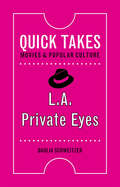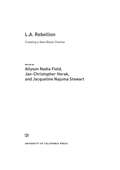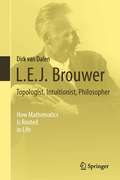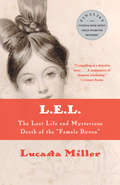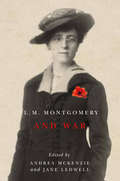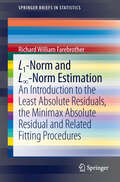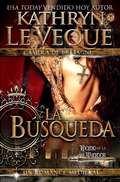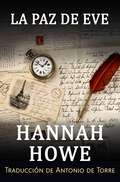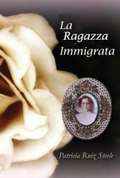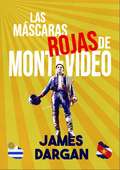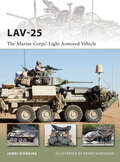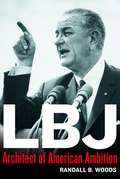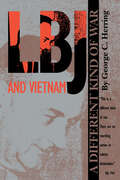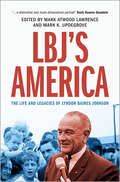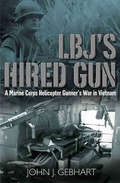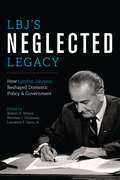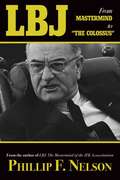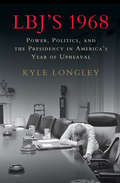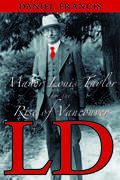- Table View
- List View
L.A. Private Eyes (Quick Takes: Movies and Popular Culture)
by Dahlia SchweitzerL.A. Private Eyes examines the tradition of the private eye as it evolves in films, books, and television shows set in Los Angeles from the 1930’s through the present day. It takes a closer look at narratives—both on screen and on the printed page—in which detectives travel the streets of Los Angeles, uncovering corruption, moral ambiguity, and greed with the conviction of urban cowboys, while always ultimately finding truth and redemption. With a review of Los Angeles history, crime stories, and film noir, L.A. Private Eyes explores the metamorphosis of the solitary detective figure and the many facets of the genre itself, from noir to mystery, on the screen. While the conventions of the genre may have remained consistent and recognizable, the points where they evolve illuminate much about our changing gender and power roles. Watch a video of the author speaking about this topic: https://goo.gl/Xr9RFD And also: https://www.dropbox.com/s/mkqw3mplruf7jje/Detective%20Talk%20Full.mp4?dl=0 (https://www.dropbox.com/s/mkqw3mplruf7jje/Detective%20Talk%20Full.mp4?dl=0)
L.A. Rebellion
by Allyson FieldL.A. Rebellion: Creating a New Black Cinema is the first book dedicated to the films and filmmakers of the L.A. Rebellion, a group of African, Caribbean, and African American independent film and video artists that formed at the University of California, Los Angeles, in the 1970s and 1980s. The group--including Charles Burnett, Julie Dash, Haile Gerima, Billy Woodberry, Jamaa Fanaka, and Zeinabu irene Davis--shared a desire to create alternatives to the dominant modes of narrative, style, and practice in American cinema, works that reflected the full complexity of Black experiences. This landmark collection of essays and oral histories examines the creative output of the L.A. Rebellion, contextualizing the group's film practices and offering sustained analyses of the wide range of works, with particular attention to newly discovered films and lesser-known filmmakers. Based on extensive archival work and preservation, this collection includes a complete filmography of the movement, over 100 illustrations (most of which are previously unpublished), and a bibliography of primary and secondary materials. This is an indispensible sourcebook for scholars and enthusiasts, establishing the key role played by the L.A. Rebellion within the histories of cinema, Black visual culture, and postwar art in Los Angeles.
L.E.J. Brouwer – Topologist, Intuitionist, Philosopher
by Dirk Van DalenDirk van Dalen's biography studies the fascinating life of the famous Dutch mathematician and philosopher Luitzen Egbertus Jan Brouwer. Brouwer belonged to a special class of genius; complex and often controversial and gifted with a deep intuition, he had an unparalleled access to the secrets and intricacies of mathematics. Most mathematicians remember L.E.J. Brouwer from his scientific breakthroughs in the young subject of topology and for the famous Brouwer fixed point theorem. Brouwer's main interest, however, was in the foundation of mathematics which led him to introduce, and then consolidate, constructive methods under the name 'intuitionism'. This made him one of the main protagonists in the 'foundation crisis' of mathematics. As a confirmed internationalist, he also got entangled in the interbellum struggle for the ending of the boycott of German and Austrian scientists. This time during the twentieth century was turbulent; nationalist resentment and friction between formalism and intuitionism led to the Mathematische Annalen conflict ('The war of the frogs and the mice'). It was here that Brouwer played a pivotal role. The present biography is an updated revision of the earlier two volume biography in one single book. It appeals to mathematicians and anybody interested in the history of mathematics in the first half of the twentieth century.
L.E.L.: The Lost Life and Scandalous Death of Letitia Elizabeth Landon, the Celebrated "Female Byron"
by Lucasta MillerA lost nineteenth-century literary life, brilliantly rediscovered--Letitia Elizabeth Landon, hailed as the female Byron; she changed English poetry; her novels, short stories, and criticism, like Byron though in a woman's voice, explored the dark side of sexuality--by the acclaimed author of The Brontë Myth ("wonderfully entertaining . . . spellbinding"--New York Times Book Review; "ingenious"--The New Yorker)."None among us dares to say / What none will choose to hear"--L.E.L., "Lines of Life" Letitita Elizabeth Landon--pen name L.E.L.--dared to say it and made sure she was heard. Hers was a life lived in a blaze of scandal and worship, one of the most famous women of her time, the Romantic Age in London's 1820s, her life and writing on the ascendency as Byron's came to an end. Lucasta Miller tells the full story and re-creates the literary London of her time. She was born in 1802 and was shaped by the aftermath of the Napoleonic Wars, a time of conservatism when values were in flux. She began publishing poetry in her teens and came to be known as a daring poet of thwarted romantic love. We see L.E.L. as an emblematic figure who embodied a seismic cultural shift, the missing link between the age of Byron and the creation of Victorianism. Miller writes of Jane Eyre as the direct connection to L.E.L.--its first-person confessional voice, its Gothic extremes, its love triangle, and in its emphasis on sadomasochistic romantic passion.
L.M. Montgomery and War
by Andrea McKenzie and Jane LedwellWar marked L.M. Montgomery’s personal life and writing. As an eleven-year-old, she experienced the suspense of waiting months for news about her father, who fought during the North-West Resistance of 1885. During the First World War, she actively led women’s war efforts in her community, while suffering anguish at the horrors taking place overseas. Through her novels, Montgomery engages directly with the global conflicts of her time, from the North-West Resistance to the Second World War. Given the influence of her wartime writing on Canada’s cultural memories, L.M. Montgomery and War restores Montgomery to her rightful place as a major war writer. Reassessing Montgomery’s position in the canon of war literature, contributors to this volume explore three central themes in their essays: her writing in the context of contemporaneous Canadian novelists, artists, and poets; questions about her conceptions of gender identity, war work, and nationalism across enemy lines; and the themes of hurt and healing in her interwar works. Drawing on new perspectives from war studies, literary studies, historical studies, gender studies, and visual art, L.M. Montgomery and War explores new ways to consider the iconic Canadian writer and her work.
L1-Norm and L∞-Norm Estimation
by Richard William FarebrotherThis monograph is concerned with the fitting of linear relationships in the context of the linear statistical model. As alternatives to the familiar least squared residuals procedure, it investigates the relationships between the least absolute residuals, the minimax absolute residual and the least median of squared residuals procedures. It is intended for graduate students and research workers in statistics with some command of matrix analysis and linear programming techniques.
LA BÚSQUEDA
by Jose Manuel Saiz de Omeñaca Monzon Kathryn Le VequeLa Búsqueda por Kathryn Le Veque Amor perdido y amor encontrado 1298 A.D. - Lady Diamatha de Bocage Edlington perdió a su marido en la Batalla de Falkirk. El duelo, no está preparada para la visita de Sir Cortez de Bretagne, que es comandante de la guarnición del Rey Edward en el castillo de Sherborne. Moreno y fiero por su herencia española, Cortez es un caballero con buena apariencia sensual y fuerte temperamento. También tiene una misión. Cortez fue el último hombre que vio al marido de Diamantha vivo y prometió al hombre moribundo que cuidaría de su mujer. Por lo tanto fue a reclamarla. Horrorizada, Diamantha se esfuerza por llegar a un acuerdo con de Bretagne, pero en su corazón hay resentimiento y odio: el cuerpo de Robert Edlington se quedó en los campos de Falkirk, donde el hombre fue visto por última vez, y de Bretagne, es el culpable. Por lo tanto, antes de que Diamantha llegue a ser la mujer de de Bretagne le solicita que le traiga el cuerpo de Robert a su hogar para un entierro apropiado. Y así, la gran Búsqueda para encontrar el cuerpo de Robert Edlington comienza... Únete a Diamantha y Cortez en su gran viaje desde los campos de Dorset a los terrenos sagrados de Falkirk, un viaje durante el cual descubrirán grandes y terribles cosas sobre el mundo, su país y ellos dos. De las cenizas del dolor asciende el fénix de gran pasión, y se forjan lazos entre Diamantha y Cortez que nunca podrán ser destruidos.
LA MISIÓN
by Noris La Valle Geraldine SolonDescripción La periodista de viajes norteamericana Sophie Matthews está buscando ese esquivo lugar llamado hogar. Su trabajo para Constar Communications le ha permitido ver el mundo y experimentar diferentes culturas, pero este estilo de vida nómade no le ha dejado desarrollar su vida personal. Próxima a cumplir los 40 años, las prioridades de Sophie cambian y decide renunciar a su trabajo en busca de un sueño diferente -conocer a un hombre, establecerse y formar una familia. Su jefe, Greg Sullivan, le pide una sola cosa: que acepte una última misión sobre la vida de la artista y escritora filipina Marina Suárez. Durante la Segunda Guerra Mundial, toda la aldea de Marina fue capturada por los soldados japoneses y ella fue la única sobreviviente de la matanza que cobró la vida de los miembros de su familia y del resto de los aldeanos. Este hecho sigue siendo un misterio para todos. Sophie está intrigada por la misión pero renuente a regresar a Filipinas, país donde diez años atrás conociera a Eric Santiago, el único hombre que había amado en su vida pero que también le había destrozado el corazón. Pronto, Sophie se encuentra en las agitadas calles de Manila y el destino hace que sus caminos se encuentren nuevamente. Mientras Sophie intenta develar el misterio alrededor de la vida de Marina, descubre que Eric es la única persona que puede ayudarla a acomodar las piezas de la historia. Pero cuando finalmente descubre el profundo y oscuro secreto de Marina, lo menos que puede imaginar es que cambiará su vida para siempre.
LA PAZ DE EVE: Una secuela de La guerra de Eve, las heroínas de la SOE (La guerra de Eve: heroínas de la SOE #13)
by Hannah HoweAmbientada en 1948, La paz de Eve es una novela breve e independiente que evoca el pasado de Eva, sus luchas en el presente y sus esperanzas para el futuro. —Estoy aquí porque Cunningham quiere que encuentre a la Kriminalrätin Gisela Winter. Trabaja para un nuevo departamento, muy confidencial. —¿La quieren para los juicios de crímenes de guerra? —Eso dijo, pero sospecho que sus motivos van más allá. —¿Por qué lo crees? —preguntó Guy. —Cunningham mostró poco interés en Gisela Winter cuando regresamos de Francia; no era una prioridad para él entonces. Creo que algo ha surgido en estos tres años, algo que ha llamado la atención de Cunningham y su nuevo departamento. Tal vez esté relacionado con crímenes de guerra, o quizá con otro aspecto de la vida de Gisela. —¿Por dónde empezarás? —Marsella. —¿Hablarás con Michel y miembros de la Resistencia? —Sí. Guy dudó. Parecía inquieto, confuso. —¿Michel aún quiere que vuelvas con él? —Sí. —¿Y tú cómo te sientes con eso? Observé el muro en la zanja. Solo quedaban los cimientos. Aun así, era notable que esa estructura hubiera sobrevivido dos mil años. Me pregunté si nuestros edificios durarían tanto. —¿Todavía lo amas? —insistió Guy. Lo miré a los ojos. —El hombre al que amo eres tú —afirmé.
LA RAGAZZA IMMIGRATA
by Carla Giannini Patricia Ruiz SteeleLa ragazza immigrata Di Patricia Ruiz Steele Era il 1911. Una storia di immigrazione spagnola raccontata attraverso gli occhi di una bambina di 9 anni. Era il 1911. Hanno lasciato tutto quello che conoscevano -- a volte anche tutti quelli che amavano -- per iniziare una nuova vita in un paese lontano chiamato Hawaii e poi in America. La loro storia di immigrazione è epica, piena di tragedia, trionfo, avversità e amore. Allontanamento e promesse. Studiare la storia spagnola e le massicce risorse sull'immigrazione la hanno aiutata a dipingere un ritratto ricco di persone che sono venuti qui e della vita che hanno creato. Questa è la loro storia di immigrazione. Manuela, la figlia maggiore di una famiglia povera di Fuentesaúco, nella provincia di Zamora, nel nord della Spagna, che prende la strada verso sud in direzione La Linea presso la Rocca di Gibilterra e la nave degli immigrati, l'ss Orteric con la sua famiglia allargata. Eccitata, ma spaventata, attende l'avventura, Hawaii e da lì, l'America, la terra promessa. Sebbene riluttante a lasciare la nonna, lei si adatta alla vita sulla nave, l'SS Orteric, ma desidera tornare sulla terra. Mentre eventi storici reali spostano la trama, influenzano i suoi pensieri, la maturità e il futuro. Questa è la vita della nonna dell'autore in cui si rivivono la Spagna e le Hawaii. È un racconto toccante sull'importanza della famiglia e sui legami culturali in cui si impara a bilanciare i valori del vecchio mondo con la promessa del sogno americano.
LA REINA PROFETICA
by Mirella Sichirollo PatzerUn gran libro que te mantendra enganchado de principio a fin por su grandiosa historia,que no te dejara indiferente,un gran libro recomendado.
LAPD '53
by James Ellroy Glynn MartinA remarkable portrait of &“true L.A. noir&” with archival photos from the Los Angeles Police Museum and text by legendary crime writer James Ellroy (Los Angeles Times). James Ellroy, the undisputed master of crime writing, has teamed up with the Los Angeles Police Museum to present a stunning text on 1953 L.A. While combing the museum&’s photo archives, Ellroy discovered that the year featured a wide array of stark and unusual imagery—and to accompany the pictures, he has written text to illuminate the crimes and law enforcement of the era. Ellroy offers context along with wild detail and rich atmosphere—this is the cauldron that was police work in the city of the tarnished angels seven decades ago, revealed in more than 80 duotone photos throughout the book. &“These crime images resemble the work of photographer Weegee, but, Ellroy argues, they&’re superior because they resist artistry; they were taken by police officers doing their jobs.&” —Chicago Tribune
LAS MASCARAS ROJAS DE MONTEVIDEO
by James DarganLAS MÁSCARAS ROJAS DE MONTEVIDEO "Camina despacio sobre las rocas" - Proverbio uruguayo Las mascaras rojas de Montevideo es una novela que abarca la historia de una pequeña porción de la república Sudamericana llamada Ururguay. Desde los primeros años en que se asentaron los españoles en el siglo 16 hasta los días moedernos de Montevideo de la década de 1970, cuando el país atravesaba una violenta crisis política. Es un cuento de fervor y masacre, de su gente y sus lugares. De las leyendas que formaron la psique de una nación pintada sobre el lienzo del paso del tiempo. Si realmente quieres comprender a Uruguy, este libro no te puede faltar.
LAS REENCARNACIONES DE ANA BOLENA
by Sandra Cifuentes Dowling Nell GavinCorre el año de 1536. Enrique y Ana están a merced de influencias que escapan a su control, han demostrado ser explosivamente incompatibles y se hallan atrapados en una historia que acabará en traición, tan feroz para Ana que requerirá de muchas vidas hasta lograr recuperarse. Enrique, aparentemente en defensa de Ana -aunque más bien por mera perversión, según la propia Ana observa-, aterroriza Inglaterra decretando asesinatos masivos por cuestiones políticas con el fin de protegerla. Ante el horror de Ana, su alguna vez apasionado esposo se vuelve finalmente contra ella y acaba ejecutándola. Esta ficción sobre reencarnaciones comienza con la ejecución de Ana. Su furia por la traición de su esposo tiene el suficiente ímpetu para perdurar siglos, pero la protagonista del libro percibe que la tarea será durísima: deberá revivir su historia junto a Enrique a lo largo de una serie de vidas pasadas y descubrir el perdón dentro de ella. La misión es muy difícil y podría tomarle largo tiempo cumplirla. El esposo en cuestión es Enrique Tudor, el famosísimo rey Enrique VIII. La narradora es la terca y voluble Ana Bolena, quien no muestra disposición alguna a perdonar. Qué duda cabe: esta es una historia de amor inusual. Las Reencarnaciones de Ana Bolena, en su versión en inglés (Threads), fue finalista del concurso William Faulkner en categoría Mejor Novela. Nell Gavin también es autora de Hang On, novela ganadora de medalla de plata en los premios Living Now Book y elegida entre las opiniones de Red Adept como título selecto con calificación de "extraordinario en su género".
LAV-25
by James D'Angina Henry MorsheadThe Light Armored Vehicle -25 (LAV-25) has played a significant role in transforming Marine Corps doctrine since its introduction in the early-1980s. The Marine Corps Light Armored Vehicle program was based on the proven Swiss MOWAG Piranha series of 4x4, 6x6, and 8x8 wheeled vehicles. However, developing organizational units, tactics, and employment of the weapon system within the force structure of the Marine Corps proved to be more of a challenge than fielding the weapon system. This resulted in multiple re-designations for LAV units within the Corps. The LAV first saw combat action in Panama during Operation Just Cause (1989); LAV-25s have fought in every major conflict since - to include the current conflicts during Operation Enduring Freedom, Afghanistan and Operation Iraqi Freedom, Iraq. During Operation Desert Storm the vehicle's record shows mixed results due to a string of friendly fire incidents; however one LAV-25 Commander earned the Navy Cross (one of only two Navy Crosses awarded to Marines during the Gulf War). The success of the LAV program has translated to several operators such as Canada, Australia, and the Saudi Arabian National Guard employing the weapon system for their own forces. This in-depth, highly-illustrated title will shed new light on this popular subject.From the Trade Paperback edition.
LBJ
by Randall WoodsFor almost forty years, the verdict on Lyndon Johnson's presidency has been reduced to a handful of harsh words: tragedy, betrayal, lost opportunity. Initially, historians focused on the Vietnam War and how that conflict derailed liberalism, tarnished the nation's reputation, wasted lives, and eventually even led to Watergate. More recently, Johnson has been excoriated in more personal terms: as a player of political hardball, as the product of machine-style corruption, as an opportunist, as a cruel husband and boss. In LBJ, Randall B. Woods, a distinguished historian of twentieth-century America and a son of Texas, offers a wholesale reappraisal and sweeping, authoritative account of the LBJ who has been lost under this baleful gaze. Woods understands the political landscape of the American South and the differences between personal failings and political principles. Thanks to the release of thousands of hours of LBJ's White House tapes, along with the declassification of tens of thousands of documents and interviews with key aides, Woods's LBJ brings crucial new evidence to bear on many key aspects of the man and the politician. As private conversations reveal, Johnson intentionally exaggerated his stereotype in many interviews, for reasons of both tactics and contempt. It is time to set the record straight. Woods's Johnson is a flawed but deeply sympathetic character. He was born into a family with a liberal Texas tradition of public service and a strong belief in the public good. He worked tirelessly, but not just for the sake of ambition. His approach to reform at home, and to fighting fascism and communism abroad, was motivated by the same ideals and based on a liberal Christian tradition that is often forgotten today. Vietnam turned into a tragedy, but it was part and parcel of Johnson's commitment to civil rights and antipoverty reforms. LBJ offers a fascinating new history of the political upheavals of the 1960s and a new way to understand the last great burst of liberalism in America. Johnson was a magnetic character, and his life was filled with fascinating stories and scenes. Through insights gained from interviews with his longtime secretary, his Secret Service detail, and his closest aides and confidants, Woods brings Johnson before us in vivid and unforgettable color.
LBJ and Vietnam: A Different Kind of War (An Administrative History of the Johnson Presidency)
by George C. HerringDecades later, the Vietnam War remains a divisive memory for American society. Partisans on all sides still debate why the war was fought, how it could have been better fought, and whether it could have been won at all. <P><P> In this major study, a noted expert on the war brings a needed objectivity to these debates by examining dispassionately how and why President Lyndon Johnson and his administration conducted the war as they did. Drawing on a wealth of newly released documents from the LBJ Library, including the Tom Johnson notes from the influential Tuesday Lunch Group, George Herring discusses the concept of limited war and how it affected President Johnson's decision making, Johnson's relations with his military commanders, the administration's pacification program of 1965-1967, the management of public opinion, and the "fighting while negotiating" strategy pursued after the Tet Offensive in 1968.
LBJ and Vietnam: A Different Kind of War (An Administrative History of the Johnson Presidency)
by George C. Herring&“[A] compelling analysis . . . A solid addition to our understanding of the Vietnam War and a president.&” —Publishers Weekly The Vietnam War remains a divisive memory for Americans—partisans on all sides still debate why it was fought, how it could have been better fought, and whether it could have been won at all. In this major study, a noted expert on the war brings a needed objectivity to these debates by examining dispassionately how and why President Lyndon Johnson and his administration conducted the war as they did. Drawing on a wealth of newly released documents from the LBJ Library, including the Tom Johnson notes from the influential Tuesday Lunch Group, George Herring discusses the concept of limited war and how it affected President Johnson&’s decision making, Johnson&’s relations with his military commanders, the administration&’s pacification program of 1965–1967, the management of public opinion, and the &“fighting while negotiating&” strategy pursued after the Tet Offensive in 1968. This in-depth analysis, from a prize-winning historian and National Book Critics Circle Award finalist, exposes numerous flaws in Johnson&’s approach, in a &“concise, well-researched account&” that &“critiques Johnson's management of the Vietnam War in terms of military strategy, diplomacy, and domestic public opinion&” (Library Journal).
LBJ's America: The Life and Legacies of Lyndon Baines Johnson
by Mark Atwood Lawrence Mark K. UpdegroveIn innumerable ways, we still live in LBJ's America. More than half a century after his death, Lyndon Baines Johnson continues to exert profound influence on American life. This collection skillfully explores his seminal accomplishments—protecting civil rights, fighting poverty, expanding access to medical care, lowering barriers to immigration—as well as his struggles in Vietnam and his difficulty responding to other challenges in an era of declining US influence on the global stage. Sweeping and influential, LBJ's America probes the ways in which the accomplishments, setbacks, controversies and crises of 1963 to 1969 laid the foundations of contemporary America and set the stage for our own era of policy debates, political contention, distrust of government, and hyper-partisanship.
LBJ's Hired Gun
by John J. GebhartMany Vietnam memoirs have appeared in recent years, but not a single one has the humor, pathos, poignancy, and often sheer hilarity of John J. Gebhart's riveting LBJ's Hired Gun. As Gebhart tells it, he was a "smart-mouthed college boy" who joined the Marines to see the world and "dust a few black pajamas for Uncle Sam." Two grueling tours of duty later (1965-1967), he returned home as a sergeant after surviving 240 combat missions (12 air medals) and being shot down twice. On his chest was the Navy Commendation Award (with the combat V). LBJ's Hired Gun launches with Gebhart's grim recollection of the intense, old-school brutality that was Marine Corps training on Parris Island before transitioning to his difficult journey for Southeast Asia aboard a troop transport with two thousand other nameless grunts. These hardships offered but a glimpse of the suffering he and his comrades were about to endure. His candid account of life and death in Vietnam is written with a lively, infectious flair. But be forewarned: No attempt has been made to sanitize this memoir with politically correct language. Gebhart tells his story exactly as he and his comrades spoke in the 1960s. The result is a gripping, no-holds-barred memoir of his "misadventures in-country." He spares no detail and no one in his effort to convey exactly what he and his comrades experienced in Vietnam. Here is how the author describes Vietnam: "What was not to like about Vietnam? It was a tropical paradise filled with lush green forests and mountains, endless rice paddies, and beautiful beaches with clear green water. You get all the free ammunition you want, endless cold beer to drink, and boom-boom girls to party with. Who could ask for more? Of course, there were some minor problems like all the VCs and NVAs who wanted to kill us. Everyone counted the days they had left before rotating back to the land of the big PX. I was having such a great vacation I signed up for another 12-month tour. I spent twenty-four action-filled months dusting VCs and NVAs, rescuing reconnaissance teams, flying LZ prep missions, delivering mail to bases where you came in shooting and flew out the same way. Somewhere along the line they decided I should be decorated for killing the enemy." This is not just another book about Vietnam written by an officer. LBJ's Hired Gun is the story of an enlisted man who lived on a dead-end street in West Philadelphia, intent on lifting your spirits and putting a smile on your face as you journey with him across the world and meet the people, explore the places, and relive the events that shaped Marine Corps history in Vietnam from September 1965 to September 1967. There are many outstanding Vietnam memoirs. LBJ's Hired Gun stands heads and shoulders above them all.
LBJ's Neglected Legacy: How Lyndon Johnson Reshaped Domestic Policy and Government
by Robert H. WilsonDuring the five full years of his presidency (1964–1968), Lyndon Johnson initiated a breathtaking array of domestic policies and programs, including such landmarks as the Civil Rights Act, Head Start, Food Stamps, Medicare and Medicaid, the Immigration Reform Act, the Water Quality Act, the Voting Rights Act, Social Security reform, and Fair Housing. These and other “Great Society” programs reformed the federal government, reshaped intergovernmental relations, extended the federal government’s role into new public policy arenas, and redefined federally protected rights of individuals to engage in the public sphere. Indeed, to a remarkable but largely unnoticed degree,Johnson’s domestic agenda continues to shape and influence current debates on major issues such as immigration, health care, higher education funding, voting rights, and clean water, even though many of his specific policies and programs have been modified or, in some cases, dismantled since his presidency. LBJ’s Neglected Legacy examines the domestic policy achievements of one of America’s most effective, albeit controversial, leaders. Leading contributors from the fields of history, public administration, economics, environmental engineering, sociology, and urban planning examine twelve of LBJ’s key domestic accomplishments in the areas of citizenship and immigration, social and economic policy, science and technology, and public management. Their findings illustrate the enduring legacy of Johnson’s determination and skill in taking advantage of overwhelming political support in the early years of his presidency to push through an extremely ambitious and innovative legislative agenda, and emphasize the extraordinary range and extent of LBJ’s influence on American public policy and administration.
LBJ's Neglected Legacy: How Lyndon Johnson Reshaped Domestic Policy and Government
by Robert H. WilsonDuring the five full years of his presidency (1964–1968), Lyndon Johnson initiated a breathtaking array of domestic policies and programs, including such landmarks as the Civil Rights Act, Head Start, Food Stamps, Medicare and Medicaid, the Immigration Reform Act, the Water Quality Act, the Voting Rights Act, Social Security reform, and Fair Housing. These and other “Great Society” programs reformed the federal government, reshaped intergovernmental relations, extended the federal government’s role into new public policy arenas, and redefined federally protected rights of individuals to engage in the public sphere. Indeed, to a remarkable but largely unnoticed degree,Johnson’s domestic agenda continues to shape and influence current debates on major issues such as immigration, health care, higher education funding, voting rights, and clean water, even though many of his specific policies and programs have been modified or, in some cases, dismantled since his presidency. LBJ’s Neglected Legacy examines the domestic policy achievements of one of America’s most effective, albeit controversial, leaders. Leading contributors from the fields of history, public administration, economics, environmental engineering, sociology, and urban planning examine twelve of LBJ’s key domestic accomplishments in the areas of citizenship and immigration, social and economic policy, science and technology, and public management. Their findings illustrate the enduring legacy of Johnson’s determination and skill in taking advantage of overwhelming political support in the early years of his presidency to push through an extremely ambitious and innovative legislative agenda, and emphasize the extraordinary range and extent of LBJ’s influence on American public policy and administration.
LBJ: From Mastermind to “The Colossus”
by Phillip F. NelsonLBJ aims to expose Vice President Johnson's active role in the assassination of President Kennedy and how he began planning his takeover of the U.S. presidency even before being named the vice presidential nominee in 1960. Lyndon B. Johnson's flawed personality and character traits were formed when he was a child, and grew unchecked for the rest of his life as he suffered severe bouts of manic depression and bipolar disorder. He successfully hid this disorder from the public as he bartered, stole, and finessed his way through the corridors of power on Capitol Hill-though records have been uncovered proving some of his aides knew of his mental illness.Phillip F. Nelson, after years of researching Johnson and the JFK assassination, concludes that during his vice presidency Johnson suffered progressively stronger bouts of mental collapse as he was busy undermining Kennedy's domestic and foreign policy initiatives for the purpose of cunningly saving them for his own legacy. His involvement with JFK's assassination is conclusively drawn with both text and photographic evidence showing Johnson's knowledge of when and where the assassination would take place. Nelson's careful and meticulous research has led him to uncover secrets from one of the greatest unsolved mysteries in our country's history.
LBJ’s 1968: Power, Politics, and the Presidency in America's Year of Upheaval
by Kyle Longley1968 was an unprecedented year in terms of upheaval on numerous scales: political, military, economic, social, cultural. In the United States, perhaps no one was more undone by the events of 1968 than President Lyndon Baines Johnson. <P><P>Kyle Longley leads his readers on a behind-the-scenes tour of what Johnson characterized as the 'year of a continuous nightmare'. Longley explores how LBJ perceived the most significant events of 1968, including the Vietnam War, the assassinations of Martin Luther King, Jr and Robert Kennedy, and the violent Democratic National Convention in Chicago. His responses to the crises were sometimes effective but often tragic, and LBJ's refusal to seek re-election underscores his recognition of the challenges facing the country in 1968. As much a biography of a single year as it is of LBJ, LBJ's 1968 vividly captures the tumult that dominated the headlines on a local and global level. Analyzes the crisis management style of a President; Features modern continuities in policymaking and political discourse, providing readers with a better understanding of the ongoing debates in today's political sphere; Highlights the challenges facing a president after five years of almost non-stop change and a rising conservative backlash.
LD
by Daniel FrancisLD is the colourful biography of Louis Taylor, the longest-serving mayor in Vancouver's history; he was first elected mayor in 1910, and served off and on until 1934, for a total of eleven years. Taylor's story is also the story of Vancouver in the early decades of the 20th century, a young city experiencing a turbulent adolescence.Louis Taylor, or LD as he was known, arrived in Vancouver from Chicago in 1896 at the age of 39. He got involved in the newspaper business, first as an executive with The Daily Province, then as proprietor of The World, during which time he built the World Tower, which remains one of Vancouver's landmark buildings (now better known as the Sun Tower).He launched his political career in 1902 when he ran successfully for licence commissioner; it was the first of 26 civic elections in which he ran, including 20 for mayor. In his early political life he was considered "the workers' friend" and was opposed by the city's business elite, who portrayed him as corrupt. He also had a reputation for being soft on crime, and was implicated in a 1928 police investigation that lost him an election. But his achievements included the establishment of the airport, a town planning commission, and the water board.His private life, however, was another story, a virtual soap opera that mirrored the ups and downs of his political career; his wife was addicted to opium, and he found himself mired in bigamy and divorce scandals.As Vancouver grew from small frontier town to a major international port city, LD saw the city through the Depression, and in a sense Vancouver grew up under his tutelage.LD: Mayor Louis Taylor and The Rise of Vancouver vividly documents the life of a man who dominated the city for years.
